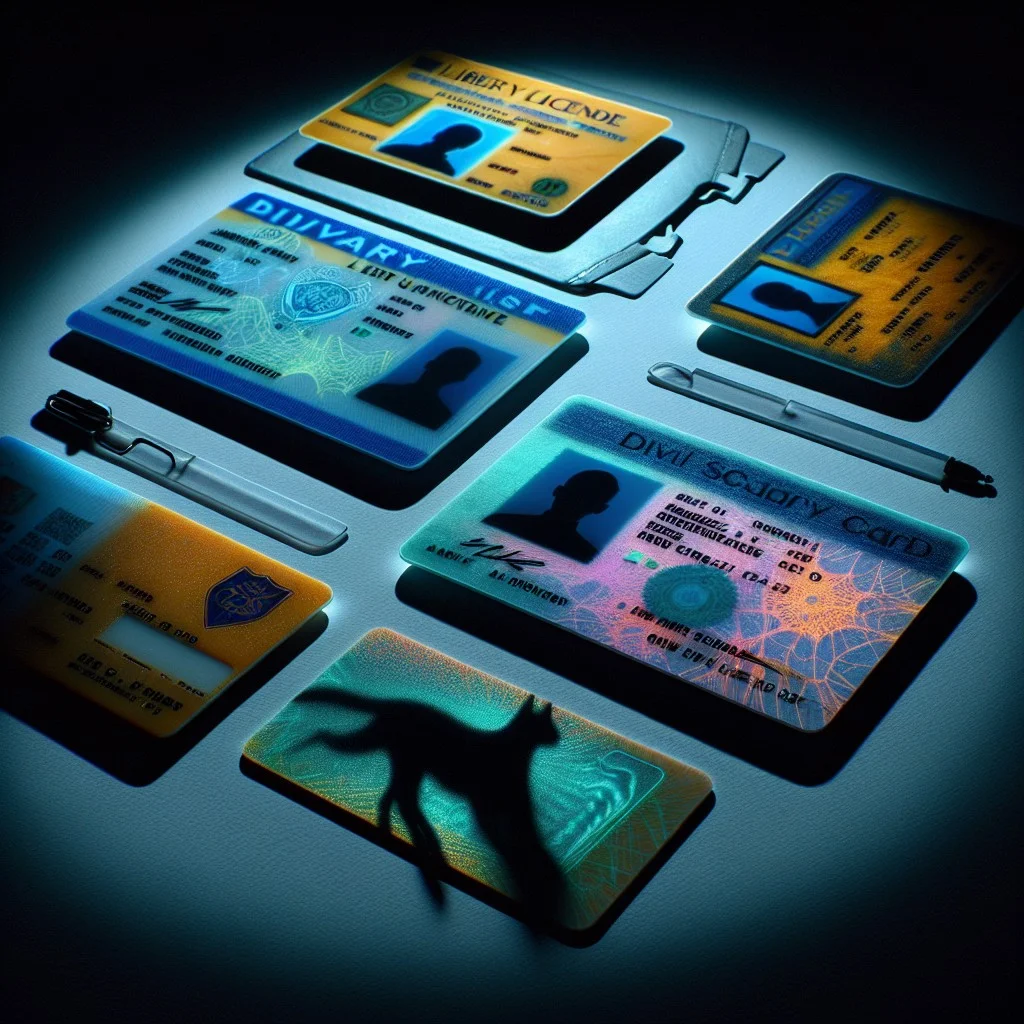Last updated on
The best technique for determining the validity of an ID is by comparing the information on the ID to official records or databases.
When determining the validity of an identification card, using the right technique can make all the difference between spotting a fake and being convinced by a counterfeit. A thorough approach combines physical examination of the ID’s material attributes with a careful review of printed information such as birthdate and potential alterations.

The resolution and authenticity of the photo also play a crucial role, as does cross-referencing the ID with other documents to ensure consistency. Whether you’re responsible for security checks, administrative verification, or simply want to protect your business from fraud, understanding these methods will equip you with the skills to discern genuine IDs from forgeries confidently.
Read on to master the detailed steps that will guide you through each part of the process for reliable ID validation.
Key takeaways:
- Physical inspection: Feel, texture, colors, edges, and details of the ID
- Checking birthdate: Logic, consistency, format, and signs of tampering
- Inspecting for alterations: Signs of tampering, font discrepancies, and lamination
- Assessing photo quality: Resolution, colors, edges, lighting, and shadows
- Cross-referencing with other forms of ID: Corroborating information and consistency
Physical Inspection of the ID
Examine the ID closely, paying attention to the feel of the card. Genuine IDs are typically made from specific materials such as PVC or polycarbonate, which have a distinct feel. Counterfeits may feel flimsy or have uneven edges.
Look for raised surfaces, especially around the photo or date of birth, which can indicate tampering or alterations. Genuine IDs are usually smooth with no irregularities.
Observe the colors and quality of the print; official documents generally have sharp and clear text with consistent coloration. Blurred text or color bleed may suggest a fake ID.
Scrutinize the edges of the ID. Authentic cards often have smooth, even, and rounded corners. If the corners are peeling or uneven, this could be a sign of a fake ID.
Lastly, check for any misspellings or incorrect information on the ID. Government-issued IDs will not have spelling errors or incorrect details like wrong height or eye color not matching the person presenting the ID.
Checking the Birthdate
Begin by confirming that the birthdate listed is logical. It should correlate with the person’s appearance, and the year should be consistent with the age they claim to be. Double-check that the date format aligns with regional standards, as inconsistencies can signal a counterfeit ID.
Additionally, compare the printed birthdate against any embossed or raised text; mismatches here are red flags. Keep an eye out for signs of tampering, such as numbers that appear altered or uneven. Remember, a genuine ID will have a birthdate that is clear, unaltered, and appropriately aged for the person presenting it.
Inspecting for Alterations
Closely examine the ID for any signs of tampering. Feel for bumps or inconsistencies on the card’s surface, which can suggest overlaid information. Look for discrepancies in font types or sizes that may point to altered text.
Pay special attention to the area around the photo and birthdate, as these are the most commonly targeted details for modification. Likewise, observe for smudged ink or irregular printing, signifiers that information might have been manually adjusted.
Lastly, check if the lamination is peeling or resealed, a clear indication of manipulation attempts. Remember, legitimate IDs will have a uniform appearance with no physical irregularities or alterations in the printed information.
Assessing Photo Quality
High-resolution images are a standard for legitimate identification cards. When examining the photo, check for clear, consistent colors without pixelation or blurring, which can signal a reproduction. Look at the edges of the photograph, as authentic IDs often have smooth transitions with the card’s surface. Discrepancies here might indicate tampering.
Additionally, lighting and shadows in the picture should appear natural and uniform, comparable to passport photo standards. If the image seems pasted on or there’s a mismatch in the background pattern, this could be a red flag for a counterfeit ID.
Checking the Back of the Card
The reverse side of an identification card holds critical information and several security features that are often overlooked. Magnetic stripes or barcodes are standard, encoded with the cardholder’s details, and must align with the information presented on the front. Always scan these features with appropriate devices to confirm their authenticity.
Additionally, look out for microtext, a common security element, which is difficult to replicate and should be clearly legible under magnification. Watermarks, which are visible when held against light, provide another layer of security, verifying that the card has not been tampered with. Lastly, pay attention to contact information or specific instructions for the card’s return if lost, as genuine IDs often provide this detail to assist with recovery.
Cross-Referencing With Other Forms of ID
Cross-referencing is a critical step in enhancing the credibility of an individual’s identity. Here are some key points to consider:
- Request additional identification to corroborate the information presented on the primary ID card. Acceptable forms include passports, credit cards, or student IDs.
- Compare names, birthdates, and signatures across the various documents for consistency.
- Look out for discrepancies in font types, sizes, or styles, which might indicate forgery.
- Take note of the condition of the secondary documents; legitimate IDs typically show uniform wear and tear.
- Be attentive to any hesitation or difficulty the holder may show when producing additional forms of identification.
Use of UV Light to Detect Security Features
UV light serves as a powerful tool for uncovering otherwise invisible security features embedded within IDs. When exposed to ultraviolet light, certain elements in the card—often in the form of patterns, symbols, or text—become visible.
These hidden features are difficult to replicate by counterfeiters. For instance, a genuine driver’s license may reveal a specific image or series of characters only under UV light. This detail is crucial in distinguishing authentic IDs from forgeries, as the level of intricacy in original holograms or UV elements is challenging to duplicate accurately.
When checking an ID with UV light, look for:
- Consistent and clear UV markings across the ID, which should not be smudgy or uncertain.
- Specific state or country UV features, which often include state seals or flags.
- Uniformity with other IDs from the same issuing body, as genuine items will display a high degree of consistency in their UV features.
Remember to handle the ID carefully while examining it under UV light and to familiarize oneself with the unique characteristics particular to the identification documents being verified.
Observation of Holograms
Holograms serve as one of the most sophisticated security features embedded in authentic IDs. They are iridescent images that change appearance when viewed from different angles, making them exceptionally challenging to replicate accurately.
When checking for the validity of an ID, it’s vital to tilt the card back and forth, observing the way the hologram morphs in response to light and movement. Authentic holograms will display a seamless transition between images or patterns, with crisp, clear colors.
Counterfeit IDs may either lack a hologram altogether, possess one that is static or does not change distinctly with movement, or show one with blurred details. Some holograms are only visible under specific lighting conditions, so it’s important to check the ID in well-lit areas or use a flashlight to reveal these optically variable devices.
Also, be familiar with the specific holographic designs used by your jurisdiction’s DMV, as these will remain consistent across valid IDs issued within the same region or category.
Verification of Laser Perforation
Laser perforation is a subtle yet effective security measure found on many modern IDs. This technique involves creating small, precise holes through the card which often form an image or a series of numbers that are not immediately noticeable to the untrained eye.
To verify these micro-perforations:
- Hold the ID Up to Light: Doing so should reveal the perforated image or numbers as light passes through them.
- Use Magnification: A magnifying glass can help discern the clean, uniform edges that genuine laser perforation produces.
- Compare with a Known Genuine ID: If you have access to a verified authentic ID, use it as a reference to understand how legitimate laser perforations should look.
- Feel the Surface: Sometimes the area around laser perforations can feel slightly recessed; feeling these subtle changes can help determine authenticity.
While laser perforation can be intricate, counterfeiters may lack the precision or equipment to replicate it accurately, making it a reliable method for validating the legitimacy of an ID.
Understanding the ID’s Security Features
Modern IDs come equipped with a variety of security features to prevent forgery. Holographic images, for example, are designed to change appearance when viewed from different angles, making them challenging to duplicate with accuracy. Similarly, microprint, or extremely small printed text, is often included and can typically only be discerned under magnification. This feature becomes a blur or is unreadable in counterfeit IDs.
Another common security element is a watermark, which is only visible when the ID is held up to the light. Additionally, some IDs contain a security thread—a thin strip embedded within the card—or use special inks that alter color when tilted. In more advanced systems, Radio-Frequency Identification (RFID) chips store the holder’s data electronically, offering an additional layer of verification that is difficult for forgers to replicate.
When verifying an ID’s authenticity, it is critical to be familiar with the specific features used in the jurisdiction from which the ID originates. Each state or country may have unique elements, and being ignorant of these can lead to misidentification of a valid ID as fraudulent. It’s wise to consult a reference guide for the IDs being examined, and whenever possible, use tools designed to highlight these security measures effectively.
Implementation of Barcode Scanning
Barcode scanning is a powerful tool that adds an extra layer of security in the validation process of IDs. Here’s a brief look into how it bolsters authenticity checks:
1. Data Extraction: Scanners interpret the information encoded within the barcode, rapidly extracting the ID holder’s details.
2. Cross-Verification: The extracted data can be compared against a database or the physical information on the ID for discrepancies.
3. Efficiency: This method streamlines the validation process, enabling quick responses in high-traffic scenarios, like entry points.
4. Forgery Detection: Alterations in barcodes are challenging and uncommon; as such, inconsistency in barcode data often flags a counterfeit ID.
5. Integration: Many smartphones and tablets can be equipped with barcode scanning apps, making this technique accessible without specialized equipment.
By combining these points, barcode scanning emerges as a convenient, reliable method to support the determination of an ID’s validity.
Utilizing Age Verification Devices
Age verification devices provide businesses a quick and efficient method to authenticate the age of a customer. These devices work by scanning the barcode or magnetic stripe of an identification card, and immediately calculating the age based on the birthdate encoded within the ID. This instant reading minimizes human error and speeds up the verification process, especially in high-volume settings like bars or retail stores.
Some points to consider when implementing age verification devices include:
- Compatibility: Ensure that the device is able to read various types of identification, from driver’s licenses to state IDs.
- Updates: Regularly update the device software to recognize the latest ID formats and security features.
- Training: Staff should be trained not only on how to use the device but also on what to do if it flags an ID as invalid.
- Reliability: Opt for devices with a proven track record of accuracy and reliability to maintain trust in the verification process.
- Regulatory Compliance: Check that the system complies with local laws and regulations pertaining to the storage and privacy of personal information.
By incorporating these devices into their workflow, establishments significantly reduce the risk of inadvertently serving minors and ensure adherence to age-related legislation.
Observation of Holder’s Behavior
When verifying identification, paying attention to the behavior of the ID holder can provide valuable cues. Nervousness or fidgeting, for example, might indicate discomfort with the authenticity of the ID being presented. Confident individuals typically have no trouble maintaining eye contact, answering questions about their age or address, and handing over their ID for inspection.
Additionally, watch for inconsistencies in actions or stories, such as difficulty recalling basic personal information or a reluctance to show supplemental identification if requested. Remember, while demeanor can be telling, it is not definitive proof of a fake ID, so consider it alongside other verification methods for a more accurate assessment.
Asking Questions That Verify Personal Information
When evaluating the validity of an identification card, a simple yet effective method is to engage the holder in conversation. Questions about information displayed on the ID should be natural and part of casual small talk, as this can reduce suspicion and increase the chance of catching inconsistencies without alerting the individual.
Consider asking for the ZIP code or full address. Many individuals using a fake ID may remember the street address but falter on the postcode. A question about their zodiac sign based on their birth date can also be telling, as those unfamiliar with astrology may not know this detail offhand.
It’s important to ask questions that don’t directly challenge the ID holder but rather help in assessing their comfort and familiarity with the information presented. If responses are hesitant or incorrect, it may warrant further inspection. Always remain polite and nonconfrontational during this process to maintain a professional atmosphere.
Guidelines for Alcohol Servers and Bartenders
Alcohol servers and bartenders play a critical role in verifying IDs and adhering to legal drinking age requirements. To effectively validate an ID, employees should:
- Be Familiar with Local Laws: Knowing the legal age and the appropriate legal steps if a minor tries to purchase alcohol is essential.
- Observe the ID Holder: A valid ID should match the person presenting it. Pay attention to facial features, height, and weight.
- Check for Tampering: Look for signs of photo replacement, erasure, or information overlay, particularly around the date of birth.
- Feel the Texture: Authentic IDs have specific textures, raised text, or other tactile features that are difficult to replicate.
- Bend the Corners: Legitimate IDs are typically made of materials that can withstand bending. A fake ID might crack or peel.
- Request a Secondary Form of ID: If in doubt, ask for another form of identification to corroborate the information provided.
- Use Available Technologies: Implement devices designed to scan and verify the authenticity of an ID, like barcode or magnetic stripe readers.
- Trust Your Instincts: If an ID sets off red flags or something feels off, it is reasonable to deny service and inform management.
Bartenders and servers should always follow their establishment’s protocols when handling suspected fake IDs.
Actions to Take If a Fake ID Is Suspected
If you suspect an ID is fraudulent, remain calm and respectful. Politely ask the individual for a secondary form of identification to corroborate the initial document.
Examine both for consistency in information and physical security features. Document the interaction, noting the ID’s details and any discrepancies that raised suspicion.
Inform the individual that the ID will need to be verified for authenticity and discreetly inform a manager or security personnel of the situation. Avoid making accusations or confronting the individual aggressively.
If the authentication process confirms the ID is fake, follow the established protocol of your establishment, which may include confiscating the ID and notifying law enforcement if required.
Remember, the goal is to ensure the validity of identification while maintaining a safe and professional environment.
Overview of Facial Recognition Technology
Facial recognition technology has revolutionized the process of ID verification by utilizing biometric software. This software compares the facial features from a provided photo on an ID card to the individual presenting it. Key areas of interest include the measurement of facial structures, such as the distance between the eyes, the shape of the cheekbones, and the contour of the jawline. These measurements are converted into a unique numerical code, or a “faceprint,” enabling the comparison.
Advancements in artificial intelligence have significantly increased the accuracy and speed of this technology. The systems can now quickly analyze the data against large databases or watchlists, helping to confirm identity or raise alerts on possible mismatches.
Despite its effectiveness, facial recognition is not without its challenges. Issues such as changes in appearance due to ageing, facial hair, makeup, or glasses can affect the technology’s accuracy. Additionally, lighting and angle of the camera can impact the system’s ability to properly read a face.
In the context of determining the validity of an ID, facial recognition acts as a strong ally, especially when combined with other verification methods. While not infallible, it adds a layer of technological safeguard against identity fraud, making it more challenging for invalid IDs to pass unnoticed.
Description of Face Recognition Apps
Face recognition apps leverage artificial intelligence and machine learning to compare the facial features from the ID photo against the individual presenting the ID in real-time. Here are key points explaining the concepts behind these apps:
1. Biometric Analysis: These apps analyze specific data points on a face, such as the distance between the eyes, the shape of the jawline, and the contours of the cheeks.
2. Real-Time Verification: The comparison happens almost instantaneously, allowing for immediate validation or denial.
3. Learning Algorithms: The software becomes more accurate over time as it learns from a vast array of facial features and structures.
4. Security Layers: Some apps provide additional security by requiring the person to blink, smile, or move their head during the scan to ensure liveness.
5. Integration with Databases: Advanced systems can cross-reference faces with criminal databases or watchlists for enhanced security measures.
Face recognition apps, when used responsibly, add a robust layer of authenticity verification, reducing the likelihood of deception with fake or altered IDs.
Pros and Cons of Facial Recognition
Facial recognition technology presents a significant advancement in ID verification, offering swift and contactless identification. An advantage is its ability to compare the photo on an ID with the person presenting it, providing an added layer of security against impostors. This technology integrates well into automated systems, streamlining entry processes for secure locations.
However, it also introduces potential privacy issues; the storage and use of biometric data create a risk for misuse or unauthorized data breaches. There’s also the chance of errors, where individuals could be incorrectly identified, especially in cases where facial features have altered or the quality of the ID photo is poor. Additionally, facial recognition systems may show biases, with varying accuracy across different demographics.
Moreover, the initial setup and maintenance of facial recognition systems can be costly, suggesting that it may not be a feasible option for all organizations. Despite these concerns, the technology remains a powerful tool, particularly when combined with other verification methods for heightened reliability.
Incorporation of Technology in Authenticating IDs
Advancements in technology have significantly bolstered the arsenal of tools available for ID validation. Biometric systems, for example, go beyond the surface details by comparing physiological characteristics against secure databases. This could include fingerprints, irises, or facial recognition patterns, adding a layer of authentication that is incredibly difficult to forge.
Smartphone applications have also emerged as convenient, on-the-go verification systems. Such apps can scan an ID’s barcode and validate the encoded information against official records. The use of machine learning algorithms further enables these apps to improve their detection capabilities over time, adapting to new forms of fraudulent IDs.
Furthermore, RFID (Radio-Frequency Identification) technology is being integrated into ID cards, allowing a contactless exchange of data. This not only streamlines the validation process but also enhances security by encrypting sensitive information, making it less accessible to unauthorized users.
Lastly, digital verification techniques are contributing to the creation of eIDs (electronic IDs), which can be more tightly controlled and updated by issuing authorities, ensuring all security features are up-to-date and reducing the window for fraudulent activities. As technology continues to evolve, so too does the potential for creating a more secure and reliable framework for ID validation.
FAQ
Which technique is best for determining the validity of a fake ID?
The optimal technique for establishing the authenticity of a potentially false ID is through the use of a basic ID scanner to implement ID parsing, a method that verifies if the barcode can be scanned and contains encoded data.
Which technique is best for determining the validity of an ID ABC test?
The optimal method for verifying the authenticity of an ID according to the California ABC test is by conducting a surface scratch with a fingernail.
Which technique is best for determining the validity of an ID scratch?
The optimal method for verifying the validity of an ID involves the visual inspection of security features, holograms, watermarks, and other authenticity indicators, alongside comparison of the ID signature to a fresh one provided by the ID holder.
Which technique is best for determining the validity of an ID compare the photograph of the ID holder?
The most effective method for determining the authenticity of an ID is by comparing the photograph on the identification to the individual who is presenting it.
What technique is most effective for validating the holographic features of an ID?
The most effective technique for validating the holographic features of an ID involves observing them under multiple angles to verify changes in the image’s appearance or color.
How can the validity of an ID be confirmed through barcode or magnetic strip analysis?
The validity of an ID can be confirmed through barcode or magnetic strip analysis by utilizing specialized devices that read and decode the unique serial data encrypted within these features, thereby verifying the authenticity of the ID.
Which method is most reliable for verifying the physical textures of an ID?
The most reliable method for verifying the physical textures of an ID is through tactile examination, ideally enhanced by technological tools designed for such audits.
Recap:



